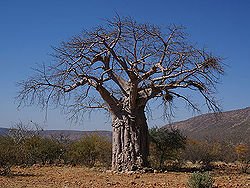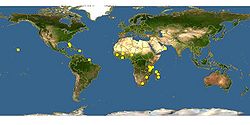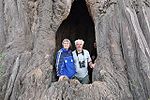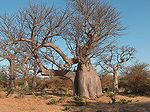Baobab
| Baobab |
|---|

|
| Scientific Classification |
|
| Binomial Name |
|
Adansonia digitata |
| The habitat range map of where the Baobab tree is located. |
The Baobab is a very unique species of tree known by the scientific name Adansonia digitata. It is also commonly known as the tree of life since so many animals can find shelter food and water around it. The uses of the tree are numerous and very useful, sometimes people call it the monkey bread tree.
The Baobab is also used as the Tree of Life in the movie "The Lion King" and the main centerpiece in Disney World's Animal Kingdom. There is also a lot of African myths concerning the tree, such as it having been taken out of the ground and buried upside down. The branches go out like roots and make it actually look like it is upside down. Some other African tribes though if you picked a flower you would be eaten by a lion. If you drank some of the water you would be eaten by a crocodile.[2]
Anatomy
The anatomy of this amazing tree is pretty magnificent. It starts with a very large trunk and can reach heights to 90 feet. At the top there are multiple branches that grow outward. This is why some people call it the upside down tree. In some African tribes, they really believe that the tree was grown from the top up. The stem is covered with bark usually 2-4 inches, and is either very smooth or ridged. The baobab bark is possibly one of the strongest barks. It is used for multiple things like: rope, harness straps, strings for musical instruments, baskets, nets, snares, fishing lines, cloth. Sometimes the bark is even consumed because of the sweet taste. Under the bark is the wood which is very strong. It is not very effective for making fires, but is very useful for constructing canoes and boats. The trunk is one of the coolest parts of the tree. Being hallow, they can store tons of water or make for a good bathroom. Some other countries found different uses for them like making it into a grave. Back up to the top where the leaves start growing, is another interesting part to the tree. The leaves are around hand size that drop in the winter time. Then the flowers come up which are about 8 inches in diameter. The fruit of the tree is large and egg shaped that is covered in yellowish brown hair. Inside the fruit is covered with a white powdery substance that's around the black seeds. The white substance inside is known to be ascorbic and can be used to drink. Only if it is downed with water and it will give you a sweet flavor to it.[3]
Reproduction
The baobab tree starts reproduction with the seeds that are stored in hairy pods. The seeds then drop from the tree and animals pick them up. Antelopes, monkeys, and elephants all consume them and disperse them throughout the land. Since they are mostly in Madagascar though, they have lemurs that spread them.[4] The Baobab is a hard tree to kill, even though there is only a few number of them in the world. They can still be burnt and stripped of bark, but will not go down all the time. The tree can grow back bark when it loses some.[3] Then when they grow their flowers, they are 6 inches wide that are sweetly scented. The pollen then gets pollinated by nocturnal creatures to move it around a little bit. When the fruit drop, they will have a egg shape with a thick covering. That fruit then gets moved around by animals and the seeds get spread. The little black seeds in them get spread around which keeps the tree going. [1]
Ecology
The Baobab tree works well with the little things that are around it. It attracts a lot of bats, which mostly distributes pollen and seeds. Some other small animals like to stay around it, but don't eat the seeds. Also some monkeys and baboons are attracted to the tree for climbing and to take some of the seeds. The Baobab tree is located in areas of South Africa, Botswana, Namibia, Mozambique, and other tropical places. It likes to be in places of hot and dry woodland. Also with well drained soil, in areas that receive low rain fall. They could be in a different area though, with high rainfall but with no frost or cold winters.[5] The tree is resistant to fire but likes water and can be with little amounts of rain or a lot. They will usually have one tree or a big group of them, depending on the soil type though. It is unable to get good anchorage, so it can't be planted in sand. It likes to have a well drained soil with sandy top over loamy substrates. [6]
Uses
The Baobab tree is very big, so it can be used for multiple different things. First the little leaves can be used as vegetables eaten raw or cooked. The fruit is a very nice part of the tree. It is very nutritious and could have more vitamin C than oranges. It also might have the same calcium content of cow's milk. In Malawi the fruit juice is used for shakes and or juice. The fruit can also be used as a cream of tarter or covered with sugar and sold. Another part that can be sold, is the seeds. They are cooked, colored, and eaten as a snack. The seeds have another purpose, which is used as a thickener for soup. Then they can be fermented, seasoned, or roasted for direct consumptions. Tanzania will use the dry pulp and ad sugar cane fermentation for beer making. It can also just be used to make a refreshing drink or eaten fresh. The pulp is also used in cereal bars smoothies for a better eating choice. The baobab is used as a source of food and water in a lot of countries. In Australia they actually made a baobab tree into a prison in the 1890s. The tree is still standing and can be seen as a tourist attraction.[7] The trunk is very important because it can be hallowed out and used for grain and water storage, and a shelter. The bark is very important to because of its richness in fiber. Which can be used to make fishnets, cords, sacks and clothing. The tree also seems to be a meeting place for African tribes or a place of worship. The wood is very different, but still can be used for timber and other things. [8]
Gallery
References
- ↑ Adansonia digitata L. baobab Author Unknown. USDA. 04/18/2011
- ↑ The Baobab Unknown Author, Baobab Solutions UK Ltd, Accessed 5/8/11
- ↑ 3.0 3.1 Baobab News Letter Christopher McMahon, White Lotus Aromatics, Accessed 4/21/11
- ↑ Baobab Tree Author Unknown. Publisher. Access 4/18/11
- ↑ Adansonia digitata Andrew Hankey, Wit Watersrand, February 2004
- ↑ Database Unknown Author, PROSEA, Accessed 5/8/11
- ↑ Adansonia Author Unknown,wikimediafoundation, Accessed 5/8/11
- ↑ The Baobab Tree Author Unknown, arted.osu, Accessed 5/8/11





